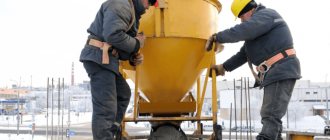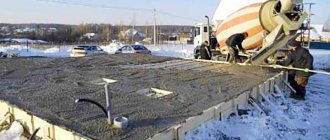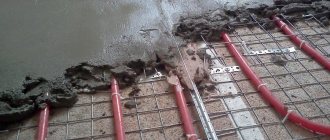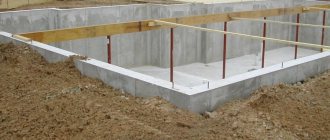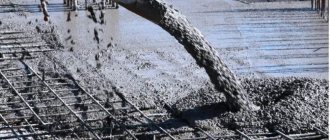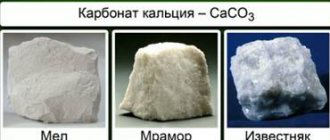The entire constructed structure depends on the strength and reliability of the foundation. That is why it is necessary to take into account the correct implementation of measures in bad weather conditions, because this may affect the strength of the foundation. If it happens that you have to pour concrete in the rain, experts recommend carefully studying the rules and stages of the work, otherwise poor-quality pouring will negatively affect the technical characteristics of the foundation.
Is it possible to pour concrete in bad weather conditions?
The main component of concrete is water. It does not cause damage to the structure being constructed, however, if there is too much liquid in the solution, then an excessive number of air bubbles are formed, for this reason the load-bearing capacity decreases. Professionals believe that concrete can be poured in the rain. The main rule is to limit the ingress of moisture above the permissible norm.
Concrete is a binding building material; its strength can only increase with wet precipitation. Therefore, it is suggested to carry out this process during light precipitation or during hot but humid weather. The rain should not be very intense, and special attention should be paid to the quality of the cement. As a rule, grades M400 and M500 are used, and, of course, it is necessary to reduce the liquid content in the concrete itself using plasticizers. These materials help to avoid voids, and the polymers contained in the composition make the resulting concrete waterproof and strong. Sediment trapped in concrete must be discharged in a layer with gravel into the soil without reducing its quality. It is important that there is no clay in the soil; it retains moisture.
Effect of humidity and temperature on hardening
The strength gain of the poured mixture largely depends on the temperature and humidity conditions. In rainy weather, there is no need for additional care, since the concrete is not exposed to sunlight and maintains a high level of humidity. As a result, water does not evaporate from the surface of the molded structure. After watching the video, you will learn how else to protect concrete from water.
A different situation occurs in hot weather. The solution dries unevenly, which can cause cracks and more serious defects to appear. In this regard, constant care is necessary. The surface of the foundation is regularly moistened with water and covered with burlap.
The full strength gain of concrete occurs within 28 days, but the initial reserve is 5-7 days. It is during this period that optimal temperature and humidity conditions must be maintained.
Difficulties working in bad weather
When working in such conditions, it is important to use cement of at least grade M400.
In rainy weather, it must be taken into account that any failure to follow the rules for mixing and pouring the solution can lead to washing out of the concrete. It is better to take a high grade of cement, for example, M400 or M500, to increase strength. If it rains heavily while carrying out work, but half of the solution has already been filled, there is no point in stopping the progress of the plan. The specific gravity of concrete is heavier than water, it will push excess moisture out. The procedure for preparing the solution if it rains is as follows:
- If excess moisture gets in, arrange a canopy made of boards and polyethylene.
- In dry form, cement and dry quarry sand are added and mixed in a ratio of 1:1.9.
- When adding water, the weight is slightly reduced by mixing in less than 0.5 mass of binder.
- Crushed stone is added in a ratio of 3.9 shares to all materials.
After placing the solution in the formwork, it can be protected from moisture by covering it with polyethylene.
For concrete to gain the necessary strength, it takes at least a month, provided it dries in fairly favorable conditions. If it is not possible to wait out the bad weather, they can build a canopy over the construction site, but this will require significant financial investments. When it rains, be sure to cover the mixture poured into the formwork with plastic wrap to prevent excess moisture from getting in and being washed out. By using vibration equipment to displace excess liquid, it will be possible to ensure that there are no air voids. Cement grades M500 and M600 are moisture resistant, their use ensures good hardening even in rain. However, their price is quite high.
The influence of rainy weather on the quality of the resulting structure
The surface may crumble if it has become saturated with moisture during pouring.
What quality the finished product will have depends on the work performed and the properties of the materials. If the concrete is waterlogged, it will begin to crumble after hardening. In addition, the mixture may wash out and the reinforcing mesh will be exposed. If, in addition to rain, the temperature drops to sub-zero levels, the water may freeze and not undergo the necessary reaction to harden. The concrete will become loose in structure, and this will affect its strength and surface quality.
Construction professionals recommend making moves to protect the bottom from mold growth. If this procedure was not completed at the beginning of construction, then cutting can be done with diamond wheels.
How can rainy weather affect the quality of the resulting concrete?
If concrete is oversaturated with liquid, it may collapse after setting. This can happen when the mixture is washed out, exposing the reinforcement mesh.
Or if water does not have time to react with cement before sub-zero ambient temperatures appear, it will freeze, and the concrete becomes loose and permeated with a network of microscopic ice floes. This phenomenon will negatively affect the strength of concrete.
What causes excess water in a concrete mixture?
It is highly not recommended to do concreting if there is a threat of water freezing. It is worth stopping the work so as not to redo it in the future. Rain can ruin the concrete surface, but if at the same time (already in a compacted concrete mixture) the adhesion processes of the concrete composition are not completed.
Tools and materials for concrete work
Concreting the foundation will require preparing a number of materials and equipment:
To carry out foundation work, materials for the solution itself are needed.
- cement, sand, crushed stone, water;
- mixing container, concrete mixer or shovel;
- construction trowel and wooden grater;
- wooden pegs;
- reinforcement grid;
- plastic film to cover the finished structure;
- vibration equipment for greater concrete density;
- spatula and building level.
Additional operations
To prevent the formation of mold under the floor, it is necessary to make additional ventilation ducts. If they were not laid at the time of pouring the foundation, we do it after it dries. Holes can be made with diamond drilling. When organizing communications, part of the foundation will need to be cut out. Used for cutting with diamond wheels.
By following all technological processes, taking into account the slightest nuances, you can achieve a high-quality monolithic foundation when it rains. Although it is still not worth carrying out work in heavy rain. Any process in construction needs to be controlled and the setting of the foundation is no exception. The weather is unpredictable, it is difficult to predict how much
Pouring stages
Builders divide the process into the following stages:
- Filling the base with a waterproofing coating.
- Installation of reinforcing mesh.
- Alternate pouring and covering with polyethylene.
The assembled formwork must be waterproofed and reinforced.
The solution should not be poured into the formwork immediately.
The area where no work is being done is covered with plastic film. After drying, the film can be removed after 1-2 days. The solution is laid out in areas one after another, when one of the elements dries, it is opened and poured on top again. After drying, the evenness of the surface and the presence of bumps are checked. If such bumps are present, they are cut off with a trowel and brought to smoothness using a wooden grater. To summarize, we can say that it is possible to pour concrete in the rain if the precipitation is not too heavy and all the conditions and stages of work are correctly fulfilled.
What factors influence the pouring of the foundation in the rain?
To carry out construction work on laying a concrete composition, it is important to choose a period when the temperature and weather conditions will be most optimal. Please note that you should wait at least a month for the concrete to receive the necessary strength and reliability!
However, what to do in a situation where the deadline for the completion of the project is running out, but it’s pouring like buckets outside, and frost is not far away? An excellent option is to build a kind of tent while the foundation is being poured. There is also a minus here - organizing a canopy on an impressive territory will require additional financial costs.
Experts have different assessments of how the foundation will behave in the rain. There is no definite answer yet. But the fact remains: during periods of prolonged precipitation, you should not manually fill a monolithic foundation.
To create a strong concrete foundation, it is important to consider the following rules:
- It is necessary to use concrete solutions in construction that contain M 400 cement. It is precisely used in the construction of foundations that come into contact with water. Increased moisture resistance is inherent in cements M 500 and M 600. They harden well during precipitation, although they are not cheap.
- The next important rule is the method in which the concrete will be laid. If the foundation is supposed to be deeply buried or of an unusual shape, then it is likely that the pouring process will have to be continuous. This will require the use of special equipment that will displace the water mass and prevent the formation of voids.
- When pouring concrete mortar into pre-prepared formwork during precipitation, the concrete should be covered with waterproofing. Polyethylene is suitable as a waterproofing material. After 2-3 days, when the mixture has completely hardened, the polyethylene can be removed.
By following the above recommendations, you can avoid the critical influence of rain before and after pouring the foundation and build a solid foundation for your future wooden house.
What grades of concrete are best to use?
When planning to build this or that building or structure, you probably took the time and studied the characteristics of the most popular brands of cement on the market, and remembered that compositions of higher grades are also more stable. Choose brands with an index of 400 and above. Such compositions help to carry out the pouring procedure with greater comfort, without worrying about the long hardening of concrete. However, be prepared for the fact that the cost of such material will be high.
Concrete grades differ in several parameters: strength, hardening time, resistance to low temperatures and granularity (the drying speed of the finished mixture depends on this indicator).
Choosing the time of year for concreting
The foundation can be poured in spring, summer and autumn. Each period has its own characteristics.
Concreting in summer
It is generally accepted that the optimal period for pouring a foundation is summer. However, in the heat, concrete dries out quite quickly, which negatively affects its quality. Rapid evaporation of moisture leads to the appearance of voids, which make the material fragile and the future structure unstable. To fill the foundation in the summer, it is advisable to adhere to the following conditions:
- the temperature during the day and night should not exceed +15-25 °C throughout the entire period of concrete hardening;
- air humidity no more than 80%;
- in hot weather, you need to care for the concrete by watering, which will prevent the formation of cracks.
The described conditions for pouring the foundation are typical for the beginning of June (depending on the region). During this period, the temperature is not too high and the humidity is most suitable. In July and August, daytime temperatures rise significantly and nights can be quite chilly. If there is a choice between these two months, then you should give preference to August.
It should also be taken into account that the maximum strength of concrete is achieved when moisture is removed from it for a long time. The solution hardens for about a month, during which the water disappears.
If work is carried out in the rain, then theoretically excess water should be drained through the crushed stone into the ground without reducing the quality of the concrete.
Spring and autumn
It is generally accepted that the autumn and spring periods, due to frequent rains and the threat of frost, are the most dangerous for pouring a foundation. Sub-zero temperatures disrupt the concrete hardening process. Temperature changes lead to stress in the most unfrozen place, which manifests itself in the form of cracks. To avoid such damage, it is necessary to use anti-frost additives, which achieve the required strength of concrete, and also monitor the weather forecast. Additionally, freshly poured concrete must be covered with film. The optimal time for concreting is the second half of spring and the first half of autumn.
Concrete can be safely poured if the temperature does not drop below zero at night. If frost is predicted, it is better to postpone the procedure to eliminate the need for alterations. It must be taken into account that if the reaction of water with cement does not begin to subzero temperatures, it will simply freeze, and the concrete will acquire a loose structure with tiny particles of ice. As a result, the quality of the foundation will be extremely low.
Purpose of the building
To fully answer the question about the possibility of concreting during rain, you should decide on the features of the future structure. If the foundation is to be poured for outbuildings, then high quality surfaces are not required. The load on such a foundation can be low due to the use of gas blocks. There are the following main types of foundations:
- tape;
- monolithic.
What happens if it rains after pouring concrete?
If, upon returning to the construction site, the bucket with cement mortar is filled with water, do not panic. The fillers are heavy, so they sink to the bottom, and the water rises to the top, that is, the liquid does not mix. You just need to pour out the excess water and mix the mixture properly.
But if the foundation pit is flooded with water, the work should definitely be stopped. It will be difficult to make a high quality base. If possible, you need to drain the pit using a drainage pump or wait until the water leaves the pit on its own.
Concrete grades
The quality of the solution plays an important role in the strength of the foundation. Prepare information about concrete, pay attention to the brand of cement. High grade cement is resistant to moisture. In the work, it is better to use concrete, the unifying component of which will be cement of a grade of at least 400. This composition allows for procedures that come into contact with water. Increased moisture resistance is inherent in cement grades 500, 550, 600. Concrete mixtures containing such grades harden quickly. But the cost of such material is not small.
Preparing a solution with less water
In rainy weather, less water will be required to mix the solution.
Consider the important nuances of the work before you start building the foundation:
- Equip a covered canopy that protects against moisture getting into the container with the prepared solution;
- At the beginning of work, pour out one part of the cement;
- Mix with 2 parts sand;
- All components are combined with water in the ratio of one part water and half the binder;
- The mixture is fixed using 4 parts gravel.
Compliance with the composition in proportion allows you to obtain strong and reliable concrete even when mixed in wet weather.
The foundation will be poured with savings in cement due to lower consumption of the main components for preparing the mixture. The resulting structure will be resistant to temperature changes and the formation of cracks, adhere better to the reinforcement base and have a reduced risk of shrinkage.
Is it worth starting work if it's raining?
You can ignore the drizzling rain, but if the weather forecasters promise heavy rain, it is better to postpone the work to another day. The optimal time of year in this case is autumn, but the risk of frost has not been canceled. Violation of the temperature regime entails stress in the unhardened concrete and freezing of the liquid. The concrete becomes loose, riddled with many microscopic pieces of ice, and cracks appear over time. Antifreeze additives will help avoid this situation.
Do I need to cover concrete from rain after pouring?
It is necessary to cover the formwork after laying the concrete mixture. Any waterproofing material is suitable for this.
Rain is not an obstacle to creating a high quality monolithic foundation. It is important to follow all points of the technological process and take into account the nuances that arise due to heavy rainfall. But it’s still better not to carry out work in heavy rain
Construction begins with the foundation. It takes on the entire load; the reliability and stability of the building depends on its strength. Until recently, it was believed that the best period for pouring the foundation was the warm season; the rainy season was not suitable for work. Currently, there are experts who believe that rain is not an obstacle to the construction process. You shouldn't stop it if it's raining.

